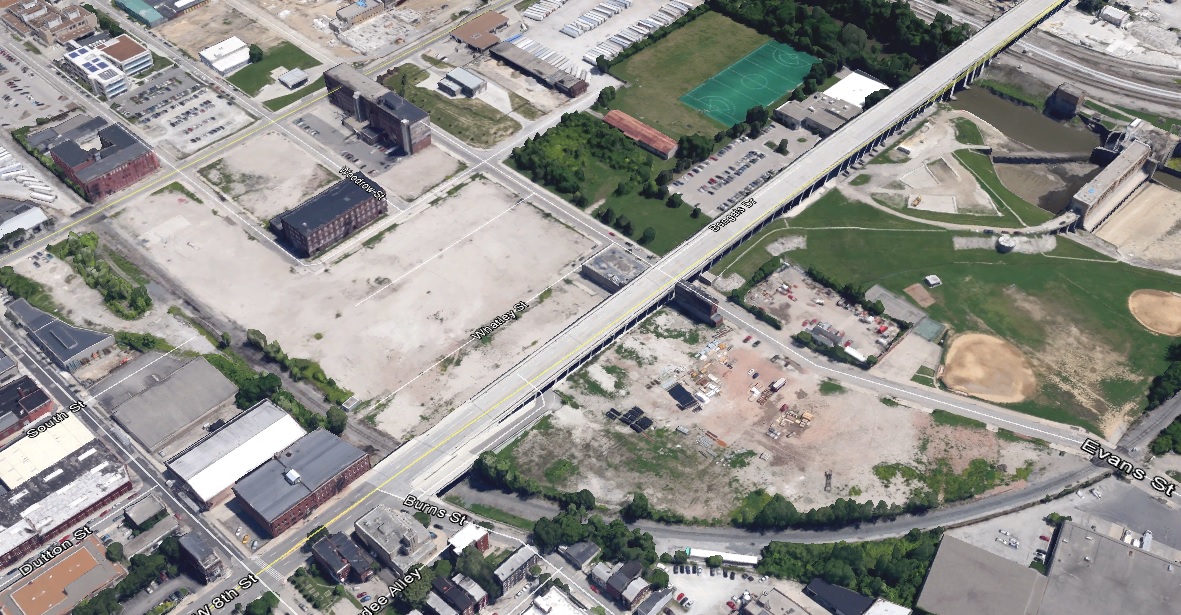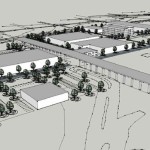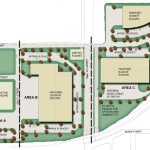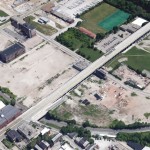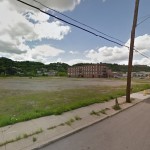Buildings ablaze 10 years ago, now long gone. The former Queen City Barrel Company site is mostly empty, but not devoid of potential.
As you travel 1.5 miles from downtown along the Eighth Street Viaduct, you pass over the 18 acres of vacant land that welcomes you to Lower Price Hill. While new construction happening elsewhere in the city is constrained by existing buildings and streets, MetroWest Commerce Park is a blank slate 4.5 times the size of a typical city block, and almost as close to downtown as Findlay Market is to Fountain Square.
Though no tenants or buyers have agreed to terms on the City-owned property, Al Neyer Inc., Resurgence Group, and Colliers International are working to market the site. Highly contaminated from previous industrial uses, redevelopment of MetroWest has been years in the making, but the City has received notice from the Ohio EPA that the site is now clean enough for new construction. Sam Stephens, an economic development officer at the city, believes in the site’s potential.
“The project is not only about cleaning up the Queen City Barrel Company site, but more importantly facilitating a development that can bring productive jobs to Lower Price Hill and positively impact the environment,” Stephens told UrbanCincy.
The team marketing MetroWest believes it is an ideal location for manufacturing thanks to its easy access to I-75, active rail lines on site, and is within 1.5 miles of downtown. Furthermore, the Metropolitan Sewer District is nearby and can offer up to 50 million gallons of any water quality daily, potentially lowering the costs for businesses that require high water use that need not be potable.
In 2008, Cincinnati completed its Growth and Opportunities Study (GO Cincinnati) with a team of national advisers in economic development and real estate. The final study categorized the Queensgate/South Mill Creek Corridor as “a generally obsolete corridor,” but also noted that “recycling South Mill Creek into the hub of green production in the region, and perhaps the nation, is indeed a unique market opportunity that could catalyze development in this aging industrial stock area.”
Perhaps serving as a contradiction is that while GO Cincinnati recommends the corridor for mostly ‘drivable sub-urban’ development, it also specifically identifies Lower Price Hill as “a ‘walkable-urban’ place, which is experiencing the beginning of a revitalization.”
The current task is marketing the site to find a buyer or tenant. Images shown to promote the site look ripped from the context of a suburban industrial park, places that are not even remotely ‘walkable-urban.’ Even though, project team members say, these images are only intended to show buildable square feet, they could quickly become reality.
The GO Cincinnati Study cites industrial tenants’ primary concern to be purely functional, with little concern for aesthetics or prestigious location. It should then fall to the City to make sure what is developed is actually beneficial to Cincinnati and the surrounding neighborhoods. Does Lower Price Hill want to welcome people on the Eighth Street Viaduct to their community with dirty manufacturing rooftops cluttered with mechanical units?
When asked about the City’s vision for the site, all of the development parties emphasized there will not be heavy industry and welcomed any interested manufacturing or light industrial businesses. Given the site’s history, and the City’s spotty responsiveness to environmental concerns in the past, the neighborhood would be right to be weary of new industrial development.
Eileen Gallagher, Lower Price Hill Community Council Secretary, says that the neighborhood is open to a variety of businesses but would want express their opinions on any business, saying, “LPH would welcome positive, safe development that would utilize potentially valuable land, create jobs, expand the city’s tax base, and perhaps give training and employment to neighborhood people.”
A vision should be expected from the city, one to which residents can respond. GO Cincinnati began that vision, but the recommendation for a “green industrial park” is not being followed. The City has owned the property for almost a decade and has spent years marketing the site without finding a buyer or tenant. Stephens, however, puts the idea of visioning a little differently.
“It’s the city’s job to serve our citizens, not define communities,” Stephens explained. However, even if Lower Price Hill creates a vision, will the City listen?
Alternative Vision: Industrial Mixed-Use with Residential
MetroWest is a few hundred feet east of Oyler School, and another few hundred feet from the LPH Community School. Paired with Evans Field Park, it will be a gateway to the future Price Landing park and Ohio River Trail West.
Increasingly, developers are recognizing the potential benefits of light industrial mixed use as manufacturing becomes greener, lighter, and cleaner. A Los Angeles study showed tax income on mixed-use development to be five times greater than solitary industrial uses. With a prime location near downtown and access to transportation, it would seem that MetroWest is a great location for residential use. Perhaps even the Eighth Street Viaduct could once again allow access to buildings from the sidewalk.
Ohio EPA’s approval for development at MetroWest, however, came with a caveat: the site can only be used for industrial and commercial uses. While the site is approved as safe, residential uses are prohibited. City officials say that the decision was made to only clean the site to commercial/industrial standards because the remediation grant would not cover the increased cost of cleaning the soil to a residential standard.
Another problem is that the site is currently zoned Manufacturing General, which would limit residential use. While the site, as is, cannot be used for residential, the decisions leading to this circumstance now appear short-sighted. Cincinnati’s zoning code is changing; and MetroWest will likely become Industrial Mixed Use (IX) in the current draft of the City’s Land Development Code. This important change would allow for residential use on upper floors, except for the covenant with Ohio EPA.
The city could go after more grant money to remediate the site to residential standards, but this would require a total restart of the remediation process – something that may very well be a bridge too far.
Alternative Vision: Sustainable Dreams
Without changing the site plan in marketing images, these are a few solutions that could significantly enhance the property.
- Densely plant trees around the building. Over time the ‘forest’ would help absorb air and noise pollution, and would be aesthetically breathtaking.
- Where deeper soil is clean enough, water gardens surrounding buildings could help contain storm water and provide an ecological habitat to complement the Mill Creek and Ohio River.
- Rooftop gardens could be used for edible or non-edible plants. If a nursery were created for native trees, any nearby resident could pick up a sapling (ash, maple, oak, walnut, cherry, locust) for free. In 40 years the neighborhood could be heavily forested. Alternatively, Kroger might be interested in a new distribution center with edible greens on their roof similar to what Whole Foods had done with one of their stores in Brooklyn, NY.
While much is not yet clear about the future of this site, it is evident that something will be built at MetroWest; and when it is, it will bring some amount of jobs to Lower Price Hill. The question now is whether a developer or industrial tenant will dictate the development, likely benefiting their own interests, or if the City of Cincinnati will work to enhance its environment with sustainable infrastructure and buildings that benefit Lower Price Hill.
